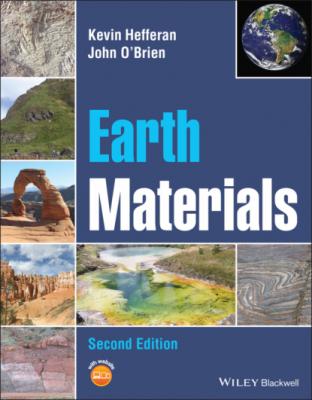Earth Materials. John O'Brien
Читать онлайн.| Название | Earth Materials |
|---|---|
| Автор произведения | John O'Brien |
| Жанр | География |
| Серия | |
| Издательство | География |
| Год выпуска | 0 |
| isbn | 9781119512219 |
3.1.2 Coupled (paired) ionic substitution
Coupled (paired) ionic substitution involves the simultaneous substitution of ions of different charges in two different structural sites in a way that preserves the electrical neutrality of the crystal lattice (Figure 3.4). The substitution of ions of different charge in one structural site changes the electric charge of the crystal lattice; this requires a second set of substitutions of ions in a second structural site to balance that change in charge. Many examples of coupled ionic substitution exist; none are more important than those that occur in the plagioclase feldspars, the most abundant mineral group in Earth's crust.
In the plagioclase feldspars, similar size ions of sodium (Na+1) and calcium (Ca+2) can substitute for one another in any proportion in the large cation coordination site. However, when calcium (Ca+2) substitutes for sodium (Na+1), the positive charge of the crystal lattice is increased, and when the reverse occurs, the positive charge of the lattice is decreased. These changes in charge are balanced by a second set of substitutions. This second set of substitutions occurs in the small tetrahedral cation coordination site where aluminum (Al+3) and silicon (Si+4) substitute for one another. When a sodium (Na+1) ion is added to the large cation coordination site, a silicon (Si+4) ion is added to the small cation structural site. The two sites together contain a total charge of +5 that is balanced by the anions in the plagioclase structure. When a calcium (Ca+2) is added to the large cation site, an aluminum (Al+3) is added to the small cation site. Once again, the two sites together contain a total charge of +5 which is balanced by the anions in the plagioclase structure. The two substitutions are paired. If a sodium (Na+1) ion replaces a calcium (Ca+2) ion in the first coordination site, a silicon (Si+4) ion must simultaneously replace an aluminum (Al+3) ion in the second structural site for the two sites to total +5, so that the electrical neutrality of the crystal lattice is maintained. Ideally all substitutions are paired and any change in the proportion of sodium to calcium (Na/Ca) in the large ion site is balanced by a similar change in the proportion of silicon to aluminum (Si/Al) in the small ion site. As a result, the general composition of plagioclase can be represented by the formula (Na,Ca)(Si,Al)AlSi2O8 to emphasize the nature of coupled ionic substitutions.
Figure 3.4 Coupled ionic substitution in the plagioclase solid solution series.
The plagioclase group can be represented as a two‐component system with coupled ionic substitution (Figure 3.4). The two end members are the “pure” sodium plagioclase called albite (Ab ), whose formula can be written as (Na)(Si)AlSi2O8 (or NaAlSi3O8), and the “pure” calcium plagioclase called anorthite (An), whose formula can be written as (Ca)(Al)AlSi2O8 (or CaAl2Si2O8). Since a complete solid solution series exists between these two end members, any plagioclase composition can also be represented by its position on a tie line between the end member components or by the proportions of albite (Ab) and/or anorthite (An). In Figure 3.4, the composition of “pure” sodium plagioclase can be represented by (1) its position on the left end of the tie line, (2) Ab100, (3) An0, or (4) the formula [(Na1.0,Ca0.0)(Si1.0,Al0.0)AlSi2O8] = NaAlSi3O8. Similarly, the composition of “pure” calcium plagioclase can be represented by (1) its position on the right end of the tie line, (2) Ab0, (3) An100, or (4) the formula [(Na0.0,Ca1.0)(Si0.0,Al1.0)AlSi2O8] = CaAl2Si2O8. Plagioclase compositions are generally expressed in terms of anorthite proportions, with the implication that the proportion of albite is (100 − Anx). An intermediate plagioclase solid solution such as the composition marked C on the tie line in Figure 3.4 has a composition that is represented by its position on the tie line, which can be represented as An35 (=Ab65). An35 can also be expressed as (Na0.65,Ca0.35)(Si0.65,Al0.35)AlSi2O8. This indicates that 65% of the large cation site is occupied by sodium (Na+1) ions and 35% by calcium (Ca+2) ions with a coupled substitution of 65% silicon (Si+4) and 35% aluminum (Al+3) existing in the small cation site.
Figure 3.5 Limited substitution and miscibility gap in calcium–magnesium carbonates with compositional ranges of low‐Mg calcite, high‐Mg calcite, and dolomite.
3.1.3 Limited ionic substitution
As noted previously, substitution is limited by significant differences in the ionic radii or charge of substituting ions. Ions of substantially different size limit the amount of substitution so that only a limited solid solution can exist between end member components. This situation can be illustrated in the rhombohedral carbonates by the limited solid solution series that exists between calcite (CaCO3) and magnesite (MgCO3). Once again, the potential solid solution series can be represented as a line between the two end members, and the composition of any calcium–magnesium‐bearing, rhombohedral carbonate may be represented by a formula, by its position on the tie line or by the proportion of an end member component (calcite = Ct or magnesite = Ms). However, because calcium cations (Ca+2) are more than 30% larger than magnesium (Mg+2) cations, the substitution between the two end members is limited. Because the amount of substitution is limited, many potential compositions do not exist in nature. Such gaps in a solid solution series are called miscibility gaps by analogy with immiscible liquids that do not mix in certain proportions. In this series, a miscibility gap exists between approximately Ms25 = Ct75 and Ms40 = Ct60 (Figure 3.5). To the left of this miscibility gap, a partial solid solution series exists between Ms0 = (Ca1.0,Mg0.0)CO3 and Ms25 = (Ca0.75,Mg0.25)CO3. Many organisms secrete shells in this compositional range (Chapter
